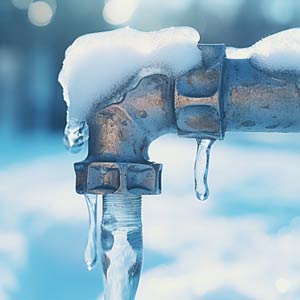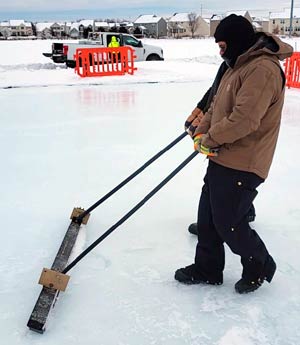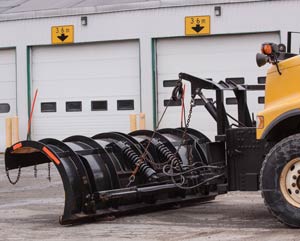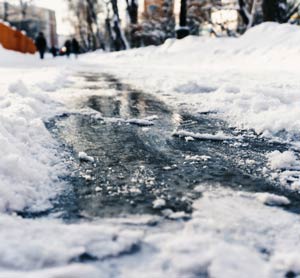
Prepping with the Pros
As winter approaches — and the Farmer’s Almanac predicts above-average snowfall for Illinois — PDRMA members are preparing their facilities and features to ensure safety for patrons and employees alike. Work is already underway at Naperville Park District, according to Tim Quigley, Director of Parks, and he’s happy to share their preparation procedures, a three-part plan for facilities, employees and equipment.
 “In October, we begin winterization of water systems including drinking fountains, irrigation, pond aerators and fountain features in the parks,” he explains. The real work, however, starts in November. “In October, we begin winterization of water systems including drinking fountains, irrigation, pond aerators and fountain features in the parks,” he explains. The real work, however, starts in November.
“Beginning Nov. 1, our fleet team starts readying winter equipment (snowplows, brooms, salters, snow blowers), and we place orders for de-icing materials,” explains Clint Burnell, Park Operations Manager of Central Parks and the Fleet Division.
Once the agency’s fall sports season ends, also in early November, they close the seasonal, nonheated restrooms. Burnell notes that sled hill setup (fencing and hay bales) has moved up in their schedule over time; the current goal is to have everything ready before the long Thanksgiving weekend.
Park district employees are part of early planning as well, Quigley says. “We assign and publish staff responsibilities early in November, along with updating snow clearing routes and maps. We also complete our training early in November to ensure everyone is ready to go before the first snowfall.”
Facility Prep
 At the agency’s unheated facilities, winter prep includes shutting off the water supply, draining lines and adding antifreeze where necessary. Staff secures closed locations with locks and signage to notify visitors. “We also check roof and sidewalk ice melt systems and gutter heaters, place deicer at building entrances and use heat tape and heaters in year-round restrooms,” adds Quigley. “During periods of extreme cold temperatures, our fuel provider places an additive in our above-ground diesel tanks to keep the fuel from gelling. We also update our website to include winter hours and pending weather closures to keep patrons informed.” At the agency’s unheated facilities, winter prep includes shutting off the water supply, draining lines and adding antifreeze where necessary. Staff secures closed locations with locks and signage to notify visitors. “We also check roof and sidewalk ice melt systems and gutter heaters, place deicer at building entrances and use heat tape and heaters in year-round restrooms,” adds Quigley. “During periods of extreme cold temperatures, our fuel provider places an additive in our above-ground diesel tanks to keep the fuel from gelling. We also update our website to include winter hours and pending weather closures to keep patrons informed.”
Staff Prep
Before winter, Naperville Park District has staff review seasonal training videos, route assignments and maps, and participate in hands-on annual equipment training. “We also make sure our employees have the necessary personal protective equipment and winter apparel by then,” Quigley adds. When there’s an approaching storm, staff meets as a team the day before or the day of the weather event, and supervisors check in with employees during breaks or lunchtime when snow removal is underway to assess priorities and resources.
The agency addresses staff scheduling during the holiday season — often a hot topic — in early November as well, so everyone knows what to expect. “We create the on-call, weekend and holiday schedules early to ensure staff knows when they have to be available, and so they can find a substitute when needed,” Quigley explains.
Equipment Prep
 Winter is when the parks department brings out its “big guns” — specialized heavy equipment to handle snow and ice removal. Quigley notes that the agency uses a variety of specialized heavy equipment for snow and ice management, including utility vehicles, pick-up and dump trucks fitted with snowplows. Winter is when the parks department brings out its “big guns” — specialized heavy equipment to handle snow and ice removal. Quigley notes that the agency uses a variety of specialized heavy equipment for snow and ice management, including utility vehicles, pick-up and dump trucks fitted with snowplows.
“We also have four dedicated snow brooms and a tractor-mounted broom for clearing the Riverwalk and trail systems,” he explains. For larger parking lots, they mount snow pusher boxes on trucks, and equip several trucks with tailgate spreaders, alongside a large V-box bulk spreader. In harsh weather, they add snow blower cabs and enclosures to equipment to keep staff safe.
“Operators inspect the equipment each week and report any issues to the Fleet division for repair,” Quigley adds. “We also encourage them to extend the equipment’s lifespan with post-event washing to remove residue.”
Winter Event Prep
 It wouldn’t be winter without holiday walks and fairs, tree lightings and festive events. Special events in winter require an extra layer of care, often at short notice. This is where Naperville has a real advantage. “We are fortunate to have two large maintenance facilities where we can park our vehicles indoors, fully fueled and loaded with snow removal equipment, ready to roll out as soon as shifts begin,” Burnell explains. It wouldn’t be winter without holiday walks and fairs, tree lightings and festive events. Special events in winter require an extra layer of care, often at short notice. This is where Naperville has a real advantage. “We are fortunate to have two large maintenance facilities where we can park our vehicles indoors, fully fueled and loaded with snow removal equipment, ready to roll out as soon as shifts begin,” Burnell explains.
How to cut the chill and its impact? “We use engine block heaters in nonheated buildings, when possible,” he says. “We also place space heaters where freezing is likely, such as restrooms and areas with sprinkler systems. Staff moves or pushes back snow piles and edges of walkways to allow for future accumulation and clearing. Crews also check restrooms — including winterized ones — during cold periods to ensure no pipes have burst.”
Tips for Staying on Top of Prep
With so much going on before, during and after the first snowfall, how do you stay on top of it all? Naperville Park District shares these prep tips:
- Advance planning — Prepare staff schedules for weekends and holidays early to allow for substitutions and reduce coverage issues.
- Equipment alternatives — Enhance productivity and minimize injuries by using alternative snow removal equipment like snow blowers, powered brooms and ergonomic tools. Power lift gates on trucks make it easier to transport snow blowers and other equipment, while reducing the amount of lifting employees need to do and keeping injuries in check.
- Leverage collaborative relationships — Coordinate with the City of Naperville’s public works department for snow removal and deicing. Naperville Park District shares locations for snow hauling, and they remove snow on trails adjacent to their properties. They also work with public works plow drivers to ensure school walk routes are clear by adjusting their snow stacking locations at intersections.
- Strategic vehicle use — Use pick-up trucks for snow plowing in high-traffic and hazardous areas (parking lot aprons near major roadways) as they offer superior visibility; use dump trucks when necessary.
- Keep the community informed — With nearly 17 miles of right-of-way sidewalks, the agency does not have the resources to clear accumulated snow at every location. They post a Snow Clearing Scope on their website to keep patrons informed, clarify their standards and set expectations. This public information reduces the number of inquiries about snow clearing in the parks.
Preparing for a safe, fun winter for visitors takes proactive planning and resource management. Follow these tips — and your agency’s winter prep plans — and make use of PDRMA’s training, tools and information to keep your agency’s facilities and features safe and fun for patrons and employees — no matter what the weather. |